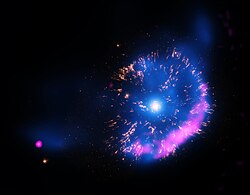
Back GK Persei AF GK Persei AST GK de Perseu Catalan GK Persei Czech GK Persei German GK Persei Spanish GK Persei French GK Persei ID GK Persei Italian ペルセウス座GK星 Japanese
| Observation data Epoch J2000.0 Equinox J2000.0 | |
|---|---|
| Constellation | Perseus |
| Right ascension | 03h 31m 11.82s[1] |
| Declination | +43° 54′ 16.8″[1] |
| Apparent magnitude (V) | 0.02[2] - 14.0[3] |
| Characteristics | |
| Spectral type | K1IV[4] |
| Astrometry | |
| Radial velocity (Rv) | 5.5[5] km/s |
| Proper motion (μ) | RA: −6.878[6] mas/yr Dec.: −17.348[6] mas/yr |
| Parallax (π) | 2.3063 ± 0.0415 mas[6] |
| Distance | 1,440+29 −26 ly (442+9 −8[2] pc) |
| Absolute magnitude (MV) | −9.1 - +3.7[2] |
| Orbit[7] | |
| Period (P) | 1.996872 ± 0.000009 d |
| Inclination (i) | 67 ± 5° |
| Semi-amplitude (K2) (secondary) | 126.4 ± 0.9 km/s |
| Details[7] | |
| White dwarf | |
| Mass | 1.03+0.16 −0.11 M☉ |
| Subgiant | |
| Mass | 0.39+0.07 −0.06 M☉ |
| Radius | 2.26 ± 0.11 R☉ |
| Other designations | |
| Database references | |
| SIMBAD | data |
GK Persei (also Nova Persei 1901) was a bright nova first observed on Earth in 1901. It was discovered by Thomas David Anderson, an Edinburgh clergyman, at 02:40 UT on 22 February 1901 when it was at magnitude 2.7.[9][10] It reached a maximum magnitude of 0.2, the brightest nova of modern times until Nova Aquilae 1918. After fading into obscurity at about magnitude 12 to 13 during the early 20th century, GK Persei began displaying infrequent outbursts of 2 to 3 magnitudes (about 7 to 15 times quiescent brightness). Since about 1980, these outbursts have become quite regular, typically lasting about two months and occurring about every three years. Thus, GK Persei seems to have changed from a classical nova like Nova Aquilae 1918 to something resembling a typical dwarf nova-type cataclysmic variable star.
Surrounding GK Persei is the Firework Nebula, a nova remnant first detected in 1902 consisting of an expanding cloud of gas and dust bubbles moving up to 1200 km/s.[11]

GK Persei has precise parallaxes reported from Gaia DR2 and Gaia EDR3,[12][6] but these are thought to be badly affected by the binary nature of the system. The Hubble Space Telescope has used a different method to derive the distance to GK Persei using nebular expansion velocity and compares that with its own astrometric parallax calculation. This gave a somewhat smaller parallax (larger distance) than the Gaia measurements.[13]
- ^ a b Cite error: The named reference
pasp109_345was invoked but never defined (see the help page). - ^ a b c Cite error: The named reference
schawas invoked but never defined (see the help page). - ^ Cite error: The named reference
GCTPwas invoked but never defined (see the help page). - ^ Cite error: The named reference
mr2002was invoked but never defined (see the help page). - ^ Cite error: The named reference
rvwas invoked but never defined (see the help page). - ^ a b c d Cite error: The named reference
edr3was invoked but never defined (see the help page). - ^ a b Cite error: The named reference
AlvarezHernandezwas invoked but never defined (see the help page). - ^ Cite error: The named reference
SIMBADwas invoked but never defined (see the help page). - ^ Cite error: The named reference
shearswas invoked but never defined (see the help page). - ^ Cite error: The named reference
warnerwas invoked but never defined (see the help page). - ^ Cite error: The named reference
noao1was invoked but never defined (see the help page). - ^ Cite error: The named reference
dr2was invoked but never defined (see the help page). - ^ Cite error: The named reference
Harrison2013was invoked but never defined (see the help page).
